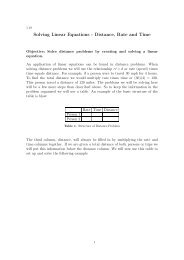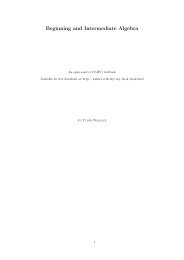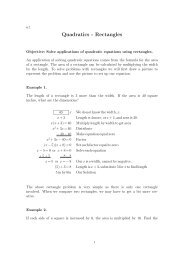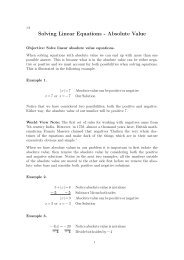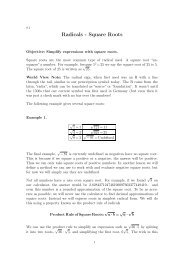Inequalities - Compound Inequalities - Wallace Math Courses
Inequalities - Compound Inequalities - Wallace Math Courses
Inequalities - Compound Inequalities - Wallace Math Courses
You also want an ePaper? Increase the reach of your titles
YUMPU automatically turns print PDFs into web optimized ePapers that Google loves.
3.2<br />
<strong>Inequalities</strong> - <strong>Compound</strong> <strong>Inequalities</strong><br />
Objective: Solve, graph and give interval notation to the solution of<br />
compound inequalities.<br />
Several inequalities can be combined together to form what are called compound<br />
inequalities. There are three types of compound inequalities which we will investigate<br />
in this lesson.<br />
The first type of a compound inequality is an OR inequality. For this type of<br />
inequality we want a true statment from either one inequality OR the other<br />
inequality OR both. When we are graphing these type of inequalities we will<br />
graph each individual inequality above the number line, then move them both<br />
down together onto the actual number line for our graph that combines them<br />
together.<br />
When we give interval notation for our solution, if there are two different parts to<br />
the graph we will put a ∪ (union) symbol between two sets of interval notation,<br />
one for each part.<br />
Example 1.<br />
Solve each inequality, graph the solution, and give interval notation of solution<br />
2x − 5>3 or 4 −x�6 Solve each inequality<br />
+ 5+5 − 4 − 4 Add or subtract first<br />
2x>8 or −x�2 Divide<br />
2 2 − 1 − 1 Dividing by negative flips sign<br />
x >4 or x � − 2 Graph the inequalities separatly above number line<br />
( − ∞, − 2] ∪ (4, ∞) Interval Notation<br />
World View Note: The symbol for infinity was first used by the Romans,<br />
although at the time the number was used for 1000. The greeks also used the<br />
symbol for 10,000.<br />
There are several different results that could result from an OR statement. The<br />
graphs could be pointing different directions, as in the graph above, or pointing in<br />
the same direction as in the graph below on the left, or pointing opposite directions,<br />
but overlapping as in the graph below on the right. Notice how interval<br />
notation works for each of these cases.<br />
1
As the graphs overlap, we take the<br />
largest graph for our solution.<br />
Interval Notation: ( − ∞, 1)<br />
When the graphs are combined they<br />
cover the entire number line.<br />
Interval Notation: ( − ∞, ∞) or R<br />
The second type of compound inequality is an AND inequality. AND inequalities<br />
require both statements to be true. If one is false, they both are false. When we<br />
graph these inequalities we can follow a similar process, first graph both inequalities<br />
above the number line, but this time only where they overlap will be drawn<br />
onto the number line for our final graph. When our solution is given in interval<br />
notation it will be expressed in a manner very similar to single inequalities (there<br />
is a symbol that can be used for AND, the intersection - ∩ , but we will not use it<br />
here).<br />
Example 2.<br />
Solve each inequality, graph the solution, and express it interval notation.<br />
2x +8�5x − 7 and 5x − 3>3x +1 Move variables to one side<br />
− 2x − 2x − 3x − 3x<br />
8�3x − 7 and 2x − 3 >1 Add7or3to both sides<br />
+ 7 +7 +3+3<br />
15�3x and 2x >4 Divide<br />
3 3 2 2<br />
5�x and x >2 Graph, x is smaller (or equal) than 5,<br />
greater than 2<br />
(2,5] Interval Notation<br />
Again, as we graph AND inequalities, only the overlapping parts of the individual<br />
graphs makes it to the final number line. As we graph AND inequalities there are<br />
also three different types of results we could get. The first is shown in the above<br />
example. The second is if the arrows both point the same way, this is shown<br />
2
elow on the left. The third is if the arrows point opposite ways but don’t<br />
overlap, this is shown below on the right. Notice how interval notation is<br />
expressed in each case.<br />
In this graph, the overlap is only the<br />
smaller graph, so this is what makes it<br />
to the final number line.<br />
Interval Notation: ( − ∞, − 2)<br />
In this graph there is no overlap of the<br />
parts. Because their is no overlap, no<br />
values make it to the final number<br />
line.<br />
Interval Notation: No Solution or ∅<br />
The third type of compound inequality is a special type of AND inequality. When<br />
our variable (or expression containing the variable) is between two numbers, we<br />
can write it as a single math sentence with three parts, such as 5 < x � 8, to show<br />
x is between 5 and 8 (or equal to 8). When solving these type of inequalities,<br />
because there are three parts to work with, to stay balanced we will do the same<br />
thing to all three parts (rather than just both sides) to isolate the variable in the<br />
middle. The graph then is simply the values between the numbers with appropriate<br />
brackets on the ends.<br />
Example 3.<br />
Solve the inequality, graph the solution, and give interval notation.<br />
− 6 � − 4x +2
3.2 Practice - <strong>Compound</strong> <strong>Inequalities</strong><br />
Solve each compound inequality, graph its solution, and give interval<br />
notation.<br />
1) n<br />
� − 3 or − 5n � − 10<br />
3<br />
3) x +7�12 or9x < − 45<br />
5) x − 6 − 1 and v − 2
3.2<br />
1) n � − 9 orn�2: ( − ∞, − 9] � [2, ∞)<br />
Answers - <strong>Compound</strong> <strong>Inequalities</strong><br />
2) m � − 4 or m < − 5 : ( − ∞, − 5) � [ − 4, ∞)<br />
3) x � 5 orx0or r < − 7 : ( − ∞ − 7), � (0, ∞)<br />
5) x8: ( − ∞ − 7), � (8, ∞)<br />
7) − 8
29) k � 2 ork < − 20 : ( − ∞, − 20) � [2, ∞)<br />
30) {All real numbers.} : R<br />
31) − 1 4 or m � − 1 : ( − ∞, − 1] � (4, ∞)<br />
Beginning and Intermediate Algebra by Tyler <strong>Wallace</strong> is licensed under a Creative Commons<br />
Attribution 3.0 Unported License. (http://creativecommons.org/licenses/by/3.0/)<br />
6



